1翻译美学导论
- 格式:ppt
- 大小:1.27 MB
- 文档页数:24
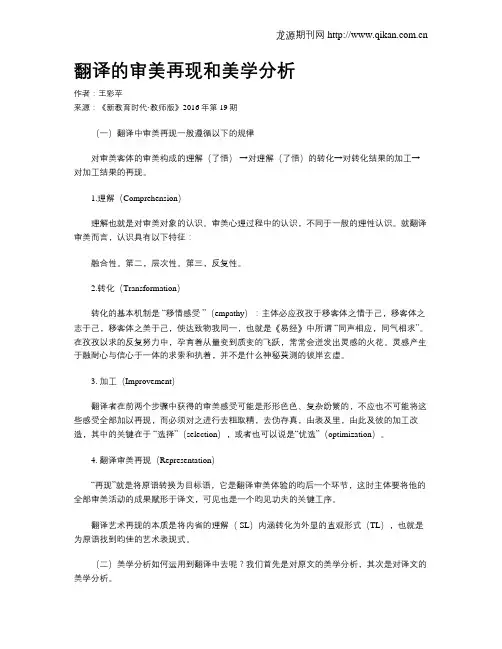
翻译的审美再现和美学分析作者:王彩苹来源:《新教育时代·教师版》2016年第19期(一)翻译中审美再现一般遵循以下的规律对审美客体的审美构成的理解(了悟)→对理解(了悟)的转化→对转化结果的加工→对加工结果的再现。
1.理解(Comprehension)理解也就是对审美对象的认识。
审美心理过程中的认识,不同于一般的理性认识。
就翻译审美而言,认识具有以下特征:融合性。
第二,层次性。
第三,反复性。
2.转化(Transformation)转化的基本机制是“移情感受”(empathy):主体必应孜孜于移客体之情于己,移客体之志于己,移客体之美于己,使达致物我同一,也就是《易经》中所谓“同声相应,同气相求”。
在孜孜以求的反复努力中,孕育着从量变到质变的飞跃,常常会迸发出灵感的火花。
灵感产生于融耐心与信心于一体的求索和执着,并不是什么神秘莫测的彼岸玄虚。
3. 加工(Improvement)翻译者在前两个步骤中获得的审美感受可能是形形色色、复杂纷繁的,不应也不可能将这些感受全部加以再现,而必须对之进行去粗取精,去伪存真,由表及里,由此及彼的加工改造,其中的关键在于“选择”(selection),或者也可以说是“优选”(optimization)。
4. 翻译审美再现(Representation)“再现”就是将原语转换为目标语,它是翻译审美体验的昀后一个环节,这时主体要将他的全部审美活动的成果赋形于译文,可见也是一个昀见功夫的关键工序。
翻译艺术再现的本质是将内省的理解( SL)内涵转化为外显的直观形式(TL),也就是为原语找到昀佳的艺术表现式。
(二)美学分析如何运用到翻译中去呢?我们首先是对原文的美学分析,其次是对译文的美学分析。
1. 对原文的美学分析:甄士隐梦幻识通灵,贾雨村风尘怀闺秀。
这是《红楼梦》第一回的目录,是一个对偶句,对仗工整,寓意深刻丰富。
“甄士隐”的谐音是“真事隐去”,“通灵”是“灵性已通”的补天顽石,就是说甄士隐在梦中见识了灵性已通的补天顽石—贾宝玉。
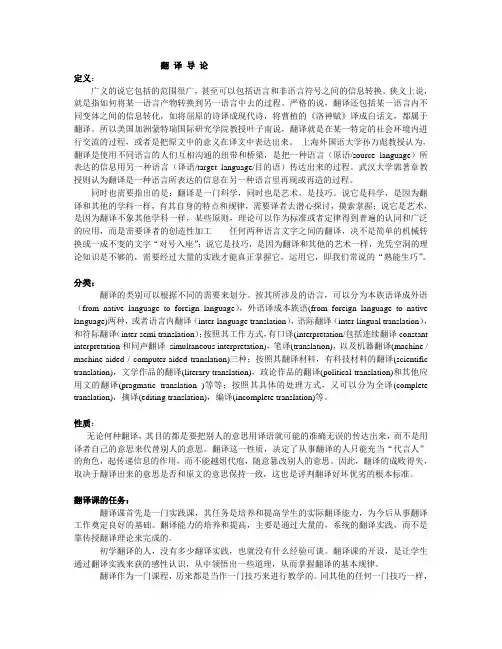
翻译导论定义:广义的说它包括的范围很广,甚至可以包括语言和非语言符号之间的信息转换。
狭义上说,就是指如何将某一语言产物转换到另一语言中去的过程。
严格的说,翻译还包括某一语言内不同变体之间的信息转化,如将屈原的诗译成现代诗,将曹植的《洛神赋》译成白话文,都属于翻译。
所以美国加洲蒙特瑞国际研究学院教授叶子南说,翻译就是在某一特定的社会环境内进行交流的过程,或者是把原文中的意义在译文中表达出来。
上海外国语大学孙万彪教授认为,翻译是使用不同语言的人们互相沟通的纽带和桥梁,是把一种语言(原语/source language)所表达的信息用另一种语言(译语/target language/目的语)传达出来的过程。
武汉大学郭著章教授则认为翻译是一种语言所表达的信息在另一种语言里再现或再造的过程。
同时也需要指出的是:翻译是一门科学,同时也是艺术,是技巧。
说它是科学,是因为翻译和其他的学科一样,有其自身的特点和规律,需要译者去潜心探讨,摸索掌握;说它是艺术,是因为翻译不象其他学科一样,某些原则,理论可以作为标准或者定律得到普遍的认同和广泛的应用,而是需要译者的创造性加工------任何两种语言文字之间的翻译,决不是简单的机械转换或一成不变的文字“对号入座”;说它是技巧,是因为翻译和其他的艺术一样,光凭空洞的理论知识是不够的,需要经过大量的实践才能真正掌握它,运用它,即我们常说的“熟能生巧”。
分类:翻译的类别可以根据不同的需要来划分。
按其所涉及的语言,可以分为本族语译成外语(from native language to foreign language),外语译成本族语(from foreign language to native language)两种,或者语言内翻译(inter-language translation),语际翻译(inter-lingual translation),和符际翻译(inter-semi translation);按照其工作方式,有口译(interpretation/包括连续翻译constant interpretation和同声翻译simultaneous interpretation),笔译(translation),以及机器翻译(machine / machine-aided / computer-aided translation)三种;按照其翻译材料,有科技材料的翻译(scientific translation),文学作品的翻译(literary translation),政论作品的翻译(political translation)和其他应用文的翻译(pragmatic translation )等等;按照其具体的处理方式,又可以分为全译(complete translation),摘译(editing translation),编译(incomplete translation)等。
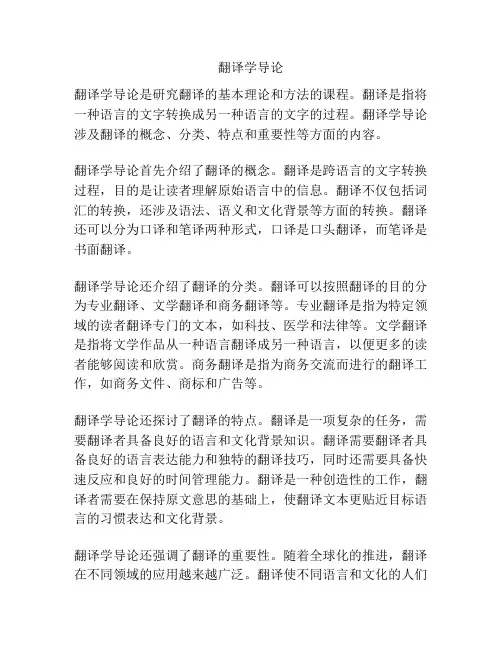
翻译学导论翻译学导论是研究翻译的基本理论和方法的课程。
翻译是指将一种语言的文字转换成另一种语言的文字的过程。
翻译学导论涉及翻译的概念、分类、特点和重要性等方面的内容。
翻译学导论首先介绍了翻译的概念。
翻译是跨语言的文字转换过程,目的是让读者理解原始语言中的信息。
翻译不仅包括词汇的转换,还涉及语法、语义和文化背景等方面的转换。
翻译还可以分为口译和笔译两种形式,口译是口头翻译,而笔译是书面翻译。
翻译学导论还介绍了翻译的分类。
翻译可以按照翻译的目的分为专业翻译、文学翻译和商务翻译等。
专业翻译是指为特定领域的读者翻译专门的文本,如科技、医学和法律等。
文学翻译是指将文学作品从一种语言翻译成另一种语言,以便更多的读者能够阅读和欣赏。
商务翻译是指为商务交流而进行的翻译工作,如商务文件、商标和广告等。
翻译学导论还探讨了翻译的特点。
翻译是一项复杂的任务,需要翻译者具备良好的语言和文化背景知识。
翻译需要翻译者具备良好的语言表达能力和独特的翻译技巧,同时还需要具备快速反应和良好的时间管理能力。
翻译是一种创造性的工作,翻译者需要在保持原文意思的基础上,使翻译文本更贴近目标语言的习惯表达和文化背景。
翻译学导论还强调了翻译的重要性。
随着全球化的推进,翻译在不同领域的应用越来越广泛。
翻译使不同语言和文化的人们能够相互交流和理解,促进了国际合作和交流。
翻译还促进了文化交流和文化多样性的发展。
翻译在经济、政治、教育和文化领域都具有重要的作用。
综上所述,翻译学导论是学习翻译理论和方法的基础课程。
通过学习翻译的概念、分类、特点和重要性等内容,学生能够了解翻译的基本知识和技巧,为今后的翻译工作打下基础。
此外,翻译学导论还培养了学生的跨文化交流和理解能力,提升了学生的语言表达和沟通能力,对于培养综合素质和提高国际竞争力具有重要意义。
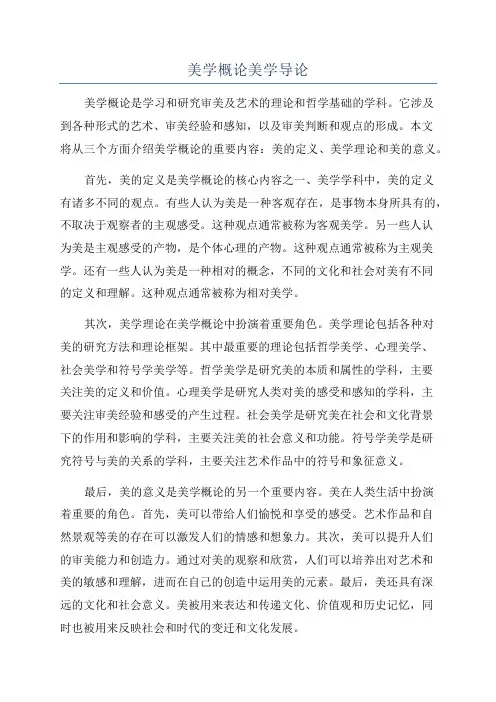
美学概论美学导论美学概论是学习和研究审美及艺术的理论和哲学基础的学科。
它涉及到各种形式的艺术、审美经验和感知,以及审美判断和观点的形成。
本文将从三个方面介绍美学概论的重要内容:美的定义、美学理论和美的意义。
首先,美的定义是美学概论的核心内容之一、美学学科中,美的定义有诸多不同的观点。
有些人认为美是一种客观存在,是事物本身所具有的,不取决于观察者的主观感受。
这种观点通常被称为客观美学。
另一些人认为美是主观感受的产物,是个体心理的产物。
这种观点通常被称为主观美学。
还有一些人认为美是一种相对的概念,不同的文化和社会对美有不同的定义和理解。
这种观点通常被称为相对美学。
其次,美学理论在美学概论中扮演着重要角色。
美学理论包括各种对美的研究方法和理论框架。
其中最重要的理论包括哲学美学、心理美学、社会美学和符号学美学等。
哲学美学是研究美的本质和属性的学科,主要关注美的定义和价值。
心理美学是研究人类对美的感受和感知的学科,主要关注审美经验和感受的产生过程。
社会美学是研究美在社会和文化背景下的作用和影响的学科,主要关注美的社会意义和功能。
符号学美学是研究符号与美的关系的学科,主要关注艺术作品中的符号和象征意义。
最后,美的意义是美学概论的另一个重要内容。
美在人类生活中扮演着重要的角色。
首先,美可以带给人们愉悦和享受的感受。
艺术作品和自然景观等美的存在可以激发人们的情感和想象力。
其次,美可以提升人们的审美能力和创造力。
通过对美的观察和欣赏,人们可以培养出对艺术和美的敏感和理解,进而在自己的创造中运用美的元素。
最后,美还具有深远的文化和社会意义。
美被用来表达和传递文化、价值观和历史记忆,同时也被用来反映社会和时代的变迁和文化发展。
综上所述,美学概论是对美的研究和理论的学科,涉及到美的定义、美学理论和美的意义。
通过对美的研究和理解,人们可以更好地欣赏和理解艺术,培养审美能力和创造力,同时也能够更好地理解和把握美在个人、社会和文化发展中的重要性和意义。
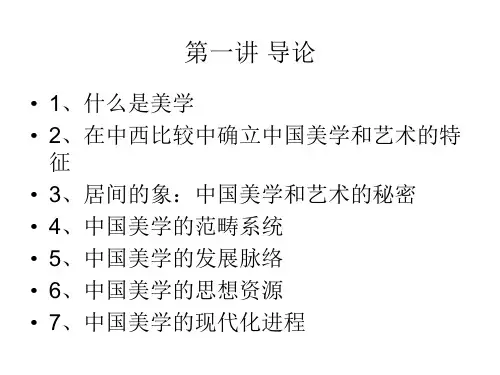
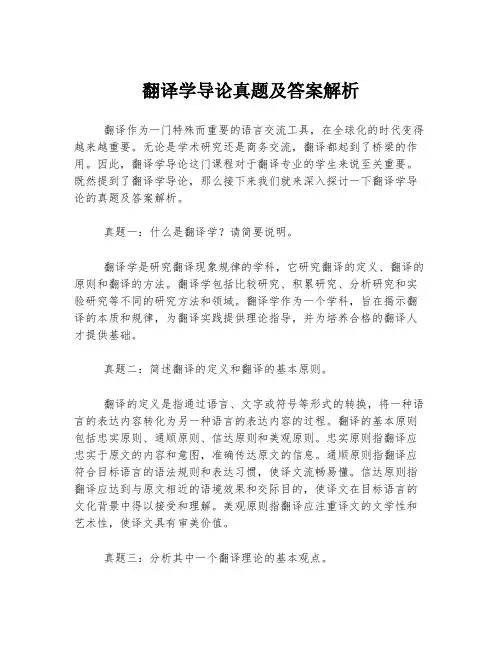
翻译学导论真题及答案解析翻译作为一门特殊而重要的语言交流工具,在全球化的时代变得越来越重要。
无论是学术研究还是商务交流,翻译都起到了桥梁的作用。
因此,翻译学导论这门课程对于翻译专业的学生来说至关重要。
既然提到了翻译学导论,那么接下来我们就来深入探讨一下翻译学导论的真题及答案解析。
真题一:什么是翻译学?请简要说明。
翻译学是研究翻译现象规律的学科,它研究翻译的定义、翻译的原则和翻译的方法。
翻译学包括比较研究、积累研究、分析研究和实验研究等不同的研究方法和领域。
翻译学作为一个学科,旨在揭示翻译的本质和规律,为翻译实践提供理论指导,并为培养合格的翻译人才提供基础。
真题二:简述翻译的定义和翻译的基本原则。
翻译的定义是指通过语言、文字或符号等形式的转换,将一种语言的表达内容转化为另一种语言的表达内容的过程。
翻译的基本原则包括忠实原则、通顺原则、信达原则和美观原则。
忠实原则指翻译应忠实于原文的内容和意图,准确传达原文的信息。
通顺原则指翻译应符合目标语言的语法规则和表达习惯,使译文流畅易懂。
信达原则指翻译应达到与原文相近的语境效果和交际目的,使译文在目标语言的文化背景中得以接受和理解。
美观原则指翻译应注重译文的文学性和艺术性,使译文具有审美价值。
真题三:分析其中一个翻译理论的基本观点。
以函数对等理论为例,它表明翻译是一种功能性的语言活动,旨在实现某种特定的语义等价关系。
函数对等理论认为翻译是一种详细的函数关系,将源语言中的输入值(原文)映射到目标语言中的输出值(译文)。
在这一理论中,翻译被视为是一种无损转化的过程,要求译文与原文在语义上保持等价,即传达相似的语义信息。
这一理论强调语言层面的功用性,将翻译视为一种对等关系,并强调在翻译过程中保持语义的一致性。
真题四:通过一个案例分析翻译中的文化因素。
举一个例子,中国传统的“寿”一词,在英语中通常直接翻译为“longevity”,但这并不能完全传达其文化含义。
在中国文化中,寿是一种吉祥的象征,代表长寿和幸福。
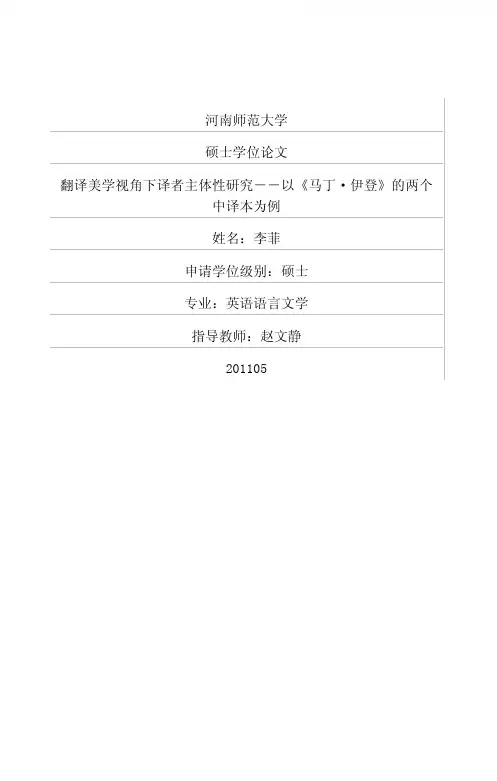
河南师范大学硕士学位论文翻译美学视角下译者主体性研究--以《马丁·伊登》的两个中译本为例姓名:***申请学位级别:硕士专业:英语语言文学指导教师:***201105摘要翻译理论与美学的结合由来已久,随着中国翻译美学理论的发展,其理论概念、分类和阐述趋于清晰化、理性化,与中国美学思想的概括性、抽象性相比,具有明显的科学性和理论适用性。
中国翻译美学理论中对审美主体、审美客体的属性及其辩证关系的讨论为译者的主体性研究提供了一个新的视角。
本文主要以刘宓庆的翻译美学理论为框架,将其应用于对MartinEden(《马丁·伊登》)的两个中译本的对比与分析,将吴劳译本的口语化和孙法理译本的文学性作为考察对象,通过对比译本的用词和句子结构,揭示两种翻译特色背后隐藏的译者的审美情感和才情,分析在译者的主体性影响下,译本用词和句子结构产生的审美效果。
本文突破了以往单纯对比译本的模式,在分析对比译本的同时,以原文为参照,检验译者主体性发挥的合理性,论证译者的主体性对翻译审美效果的影响,印证了刘宓庆的翻译美学理论的合理性。
本文的对比分析旨在揭示译者的主体性对审美再现效果的影响,并对口语化和文学性两种表达方法的合理运用提出了建议,以期在审美角度对译者主体性的研究有所贡献。
笔者在运用刘宓庆的翻译美学理论探析译者主体性的同时,也对该理论进行了批判。
刘宓庆先生在《翻译美学导论》一书中对审美主体、审美客体及其辩证关系等问题的分类和阐述更明晰、合理,较早期的美学思想有很大的进步,但在讨论译者主体性与审美效果的关系方面,缺乏足够的方法论指导。
例如,在探讨译者的才情时,只是对译者的语言分析能力、表达法分析能力等做了阐述,并没有说明什么样的分析才是符合或接近审美标准的。
关键词:翻译美学,译者主体性,审美情感,口语化,文学性AbstractAtthebeginningoftheformationofChinesetranslationaesthetics,itsconceptsareabstract.However,withthedevelopmentofChinesetranslationaesthetics,theconcepts,classificationandinterpremtiontendtobeclearandrational.ComparedwiththeabstractnessofChineseaestheticthoughts,Chinesetranslationaestheticsisscientificandapplicable.Thediscussionofattributesofaestheticsubjectandaestheticobjectandthedialecticalmlmionshipbetweenthemprovidesthestudyoftranslator’SsubjectivitywithanewTakingLiuMiqing’Stheoryoftranslationaestheticsasaframework,especiallybyusinghistermsonaestheticsubject,thisstudyanalyzesthesubjectivefactorintheprocessoftranslationofMartinEdentodemonstratehowtranslatorsplaytheirsubjectiverolesandbreakthroughobjectiveconditioning.Intheprocessofanalysis,comparisonismainlymadebetweentwotranslatedversionsandtheoriginaltextisareferencetotestifywhetherthesubjectivityisreasonableornotandtoexploretheextenttowhichthedifferenttranslationisaffectedbythesubjectivityofthetranslator.Thestlldyattemptstorevealhowaestheticfeelingandcapabilityoftranslatorsbringinfluenceontheeffectsofaestheticrepresentation,andgivesomesuggestionsabouttheuseofcolloquialismandliterafiness.Thisdissertationattemptstocontributethegrowingstudyonsubjectivityofthetranslatorfromperspectiveoftranslationaesthetics.ThestudyalsoattemptstoassessLiuMiqing’Stheoryoftranslationaestheticsintermsofitslackofspecificguidanceoftranslationapproaches.Forexample,inthediscussionofcapabilityofthetranslator,Prof.Liujustinterpretsthecapabilityoflanguageandexpressionanalysis,hedoesnotgiveaclearcriterion011whatkindofanalysiscanbeconsideredasconformingtotranslationaesthetics.KEYWORDS:translationaesthetics,translator’Ssubjectivity,aestheticfeeling,colloquialism,litcrarinessAcknowledgementsIIIIIIIll11111IIIIII\1960595Theprocessofworkingonthisstudyhasbeenavaluableexperienceforme.MysinceregratitudegoesfirsttoProf.ZhaoWenjing,mysupervisor,forsheconstantlygavemeinstructionsandencouragement.Duringthecomposingofthedissertation,sheintroducedmesomerelevantreferencebooksandpatientlyofferedmeimportantadvice.Shegavemetheconfidencetodotheresearchontheissueoftranslationaesthetics.Withoutherinstructionsandencouragementthisdissertationcouldnotreachitspresentform.Furthermore,thespiritofherdevotiontoworkandthe8a18eofresponsibilityinspiredandwillinspiremetoworkhard.ManythanksgototheinstructorsattheSchoolofInternationalStudies.Manythanksalsogotomygroupmemberswhoactivelyorganizedandattendeddiscussioninthepastthreeyears.Throughthesesignificantacademicactivities,Igainedknowledgeandpleasure.IappreciateverymuchtoMcngXiaoli,myclassmate,whoenlightenedmeinthelogicalthinkingwhenIdesignedtheoutlineandstructureofthisdissertation.ManythanksalsogotoChenDongxia,whopatientlycorrectedtheerrorsinmydissertation,andtoTianLi,whosesmileandbehaviortoldmetheimportanceofconfidence--themostvaluablequalityforeachp吼'son.ChapterlIntroductionChapterIIntroductionThroughoutthehistoryoftranslationtheoriesofwestandChina,translationaestheticshasitson#nofphilosophy.ThedifferenceliesinthefocusOnthevirtueofbeautyinthewest(sceLiuMiqing2005:57)andthedebateofWen(文)andZhi(质)inancientChina.Withthedevelopmentoftranslationstudies,westerntranslationtheoriesturntobelinguisticorientedandseparatedfromaesthetics(8eeLiuMiqing2005:58).WhatisdifferentfromwesterntranslationaestheticsisthatChinesetranslationstudieshaverelatedtoChineseaesthetics;whatismore,“theallianceoftranslationandaestheticsisanimportantfeatureofChinesetranslationtheories.”(LiuMiqing2005:i)Forcenturies,theconceptsofancientChineseaestheticthoughtstendtobefuzzyandfocusontheformofexpressionandperception,thus,fromthetranslationoftheBuddhistScriptureson,translationaestheticshasthesamecharacteristicsundertheinfluenceoftraditionalaestheticthoughts.Thethoughtsandideasarealwaysabstractandscattered.WithrecentdevelopmentsinChinesetranslationaesthetics,inparticularthepublishedmonographsoffamoustranslatorsandtranslationscholarsinrecentyears,theelementsrelatedtotranslationaestheticsareclear.Inaddition,theresearchandcategoryhavealsobecomerational,specificandsystematic.Thebeautyoforiginaltexts(oraestheticvalueoforiginaltexts)andtargettexts,theroleoftranslatorsaretakenintoconsiderationinthosemonographs.However,fromtheperspectiveoftherelationofsubjectandobject,whichissimilartotheconceptsofphilosophy,theclassificationofconceptsandthearrangementofchaptersinLiuMiqing’SIntroductiontoTranslationAesthetics(2005)areclearer.Inthisbook.thenotionsofaestheticobject,aestheticsubject,therelationbetweenthemandthelevelsofaestheticsalesystematicallyinterpreted.Thisismoreconvenientforthestudyinthisdissertation.AccordingtoProf.Liu’Sillustration,translationaestheticsubject(TASforshort)mainlyreferstOtranslators,andtheattributesofTASaredividedintotwoaspects:objectiveconditioningandsubjectivedynamics.Inthisdissertation,thediscussionoftranslator’ssubjectivityputsemphasisonsubjectivedynamics.InProf.Liu’sbook,subjectivedynamicsincludesfouraspects,namelyaestheticfeeling,knowledge,capabilityandtenacity.Inthisdissertation,thediscussioncentersollaestheticfeelingandcapability.Inthebeginningoftranslation,translator’SaestheticfeelingunconsciouslydeterminesthetoneAStudyonTranslator’sSubjectivityfromthePerspectiveofTranslationAestheticsofthewholetranslatedversion,andtranslatorshavedifferentaestheticfeelings,thisdifferencedirectlycause3thedifferenceofwordingandothertranslationapproaches.SoisthecasewithdifferentfeaturesofWuLao’SandSunFali’Stranslation.Mr.Wh’ScolloquialismandMr.Sun’Sliterarinessreflectstheiraestheticfeelingsandcapabilities,inturn,theiraestheticfeelingsandcapabilitiesdeterminethedifferentfeatures---colloquialismandliterariness.Therefore,aestheticfeelingandfeaturesoftranslationareinacomplementaryrelation.Fromtheperspectiveoftranslationaesthetics,thegoretaskoftranslatorsistomakeaestheticaltranslatedversions,andtheprocessoftranslationinvolvesaestheticfeelingandtheformationofdifferentfeatures.ThisstudytakesLiuMiqing’StheoryoftranslationaestheticsasaframeworkandreconsidersoneofmasterpiecesbyJackLondon----MartinEdenbycomparingitstwoChinesetranslatedversions.SOastodemonstratehowtwofamoustranslatorsrepresentitsaestheticvalue.Thisdissertationexamineshow,intheprocessoftranslation,aestheticfeeling,idealandcapabilityoftranslatorsbringinfluenceontheeffectsofaestheticrepresentation,andhowtranslatorsbreakthroughtheobjectiveconditioningoforiginaltext.Onthebasisofthisanalysis,thisdissertationalsoprovidessomecriticalreflectionsontranslationaestheticsandsuggestionsabouttranslationcritics,whichshoulddoprofessionalcriticismonliterarytranslationandhelptoelevatereaders’levelofappreciation.Inwhatfollowsinthisintroduction,thereasonofselectingMartinEdenandtheissueoftranslators’subjectivityisgiven,andfinallythestructureofthisdissertationisintroduced1.1RationaleforFocusingonMartinEdenandtheTranslator’SSubjectivityMartinEden,JackLondon’Ssemi-autobiographicalnovel,isoneofJackLondon’SmasterpiecesinhisliterarycarP.A!l'.KnownfromYuJianhua’sbook《杰克伦敦研究》(TheStudyonJackLondon)(2009).thestudyofJackLondoninhisnativecountryhasexperiencedawindingcourse.Treated8.8spotlightordismissedfrommainstreamofcriticalattention,thecriticismofJackLondon’Sworksisalwaysrelatedtopoliticalfactor,“politicalutilitarianprevailsOVeraestheticmotives”(YuJianhua2009:359).TakingtranslationaestheticsandMartinEden8.8keywords,theauthorgoteightthesesaboutMartinEdeninCNKIdatabaseinthetimespanof1999-2011andallarewrittenfromtheperspectiveofliterature.Asanovelofindividualstruggling,itisofgreatsignificancetoyouthtoda弘ThissignificancealsoreflectsChapterlIntroductionthegreatnessofMartinEden.Oneofaestheticobject’Sattributesisthatitallowsthechangesofaestheticvaluewiththedevelopmentofsociety.Then,howistheaestheticvaluerepresentedintranslation?WhetherCallthetranslatorsaccomplishthisdayAndwhatfactorsaffecttheroleoftranslators?Thetheoryoftranslationaestheticsishighlyproductivefortheanalysisofsubjectivefactorssuchasaestheticfeelingandcapabilitywhichisreflectedintheprocessoftranslation.translatorsassubjectsAmongthesixarticleswrittenbyfamoustranslationscholars,abouttheissueofandsubjectivityofthetranslatorsfromtheperspectiveofphilosophyorinterpretation,onlyonearticlebyXuJunin2003claimsthatthecoreoftranslators’subjectivityisaestheticrequirementandaestheticcreativity.ExistingstudieshaveSOfarfailedtogiveanadequateaccountofthetranslator’Ssubjectivity.1.2StructureoftheDissertationThisdissertationattemptstodemonstratethathowtranslator’ssubjectivitybringsgreatinfluencesonaestheticeffects.andgivessomesuggestionontheuseof‘'colloquialism’’and“literariness’’(QinXiubai2002:53).Chapter2thendiscussestherelationbetweenaestheticsandtranslation,outliningitsoriginanddevelopments,andintroducessometranslationproperinLiuMiqing’SmonographIntroductiontoTranslationAesthetics.EdenandprovidessomecriticalcommentsonChapter3outlinesthemainaestheticvaluesofMartinthebasisofexamplesexcerptedfi'omthenovel.ThefourthChapterintroducestheattributesoftranslator’Ssubjectivity,subjectivedynamicsandobjectiveconditioning.Amongfouraspectsofsubjectivedynamics,thisdissertationselectstwoaspects,aestheticfeelingandcapability,whicharereflectedmuchmoreinthetranslationofMartinEden.Chapter5mainlydiscussesthedifferencesofthetwotranslatedversionsfromtheaestheticeffectstodemonstratehowtranslatorspromoteadvantagesandmakeupforshortcomings.demonstratestheapplicabilityoftranslationChapter6summarizesthefindingsofthestudy,notonlyaestheticstothepracticeofthetranslationofMartinEden,butalsoindicatesthefutureresponsibilityoftranslationcriticismandassessesLiuMiqing’Stheoryoftranslationaestheticsintermsofitslackofspecificguidanceoftranslationapproaches.Chapter2AestheticsinLiteraryTranslationChapter2AestheticsinLiteraryTranslationTracingbacktheoriginofaesthetics,wediscoverthataesthetics,infact,iscalledinthenameofphilosophyandaesthetics(LiuMiqing2005;ManRonggui2005;ShanJigang2007).Aspracticeoftranslationisgraduallydeepening,especiallywiththeextendingandtheunderstandingofaestheticsinChinesetranslationcircle.aestheticsisrelatedtOmanydisciplinesbesidesitsrelationship诵吐lliterarytranslation.Forinstance,tosomeextent,thetranslationofarticlesofscienceandtechniqueisalsorelatedtoaesthetics.Inthiskindoftranslation,thetransparencyCanbesP_圮nasanelementofaesthetics.Therefore,thereisstillaneedtoemphasizethatthefocusofthisdissertationistheaestheticsinliterarytranslation,notincludingothertypesoftranslation.A3toliterarytranslation,itisnecessarytointroducesimplyitscharacteristics80弱tonaturallydiscusstheissuesofaestheticsandevenhowtoachievethetranslationaestheticsintheprocessoftranslation.2.1TheCharacteristicsofLiteraryTranslationTheinductionofthecharacteristicsofonethingdependsontheunderstandingofitsdefinition;similarly,summarizingthecharacteristicsofliterarytranslationmakesnecessarythedefinitionofliterarytranslation.ThereisnoexplicitdefinitionofliterarytranslationinBaker’SRouaedgeEncyclopediaofTranslationStudies.AsBaker(2004:130)said,thedefinitionofliteratureandtranslationarenotsimpleorwelldefilledinmostcultures.Significantlyandusefully,thewordsofliterarytranslationfrompage130toandelaboratedexplanations,andrespectivelyknowwhattheliteratureisandpage133givereadersclearwhatthetranslationis.Literatureisalwayslinkedtoliterarytraditions,style,andgenreandSOon.Thetranslationhasnoborderlineswithadapmfionandrewriting.Indeed,inmostwesternsocieties,conceptoftheveryconceptoftranslationhasbeenreducedtoliterarytranslation(seeBaker2004:130·133).Since“literaturesaretiedtoparticularlanguages”(Baker2004:131),andbylearningfromM.GRose(2007:13),“literarytranslationisatransferofdistinctivefeaturesofaliteraryworkintoalanguageratherthanthatofthework’Sfirstcomposition”,itcanbesafelysaidthattheoriginaltextisthestartingpointofliteraryandaestheticelementsintheoriginaltextmustbetranslation,intheprocessofwhich,theinformation垒兰坐堂旦旦!堕璺!!坐21:!兰竺竖型!兰堡垒2竺£!竺£暨!兰竺!:!塑翌型!!12翌垒竺!!壁一一一一一..reflected.Thedistinctivefeaturesofaliterarywork,suchasrhetoric,genreandsoon,determinethecharacteristicsofliterarytranslation,mustbeconveyedinthetranslation..What,then,arethedistinctivefeaturesofaliterarywork?Novels,shortstories,plays,poems,etc.Canbecategorizedasliteraryworks.Literatureisakindofart;itistheauthor’scomprehensionabouttheoutsideworldatthattime.Theauthor’sfeelings,values,exp甜enceandknowledge,allofthemareencodedinliterarylanguage.However,onepointshouldbepaidmoreattention.Literarylanguagefeaturesvividandaestheticdictions,intentionalfigures,plottingand80on.Onsyntacticlevel,itisrichinvariedsentencepatterns,longandshort,alsosentencesandSOon,whichdependsoncontentincludingellipticalandtheauthor’Spreference.Infact,thesecharacteristicsmainlyserveitsfunction.Itaimstoexpressone’Semotionbyfocusingonthedescriptionofimage,feelings,spiritandthinking,andtherelationshipbetweenmealandnature.Thesearethecontentofaliterarywork,andthelanguageistheform.Therefore,theformandthecontentshouldbebothrepresentedintranslatedversion,evilthoughrepresentationcannotbeachievedabsolutely.Theformandthecontent(orcanbecalledmaininformation)arethebasisorthereferencefortranslation,thispointisthescientificcharacteristicsofliterarytranslationbesidesitsartisticfeature.Astoliterarytranslation,manyscholars,asfarasIreadintheirbooks,inevitablyresearchtheissueofreproduction,recreationorrepresentation(differentscholarsusedifferentterms)inliterarytranslation.ThereisonepointtoSeethattheartandliterature,theartandliterarytranslation,therelationshipbetweenaestheticsandliteratureisclose,SOisthecasewithaestheticsandliterm'ytranslation.Alloftheserelationshipsmakethefollowingintroductionofaestheticsnecessary.2.2TheStudyofTranslationAestheticsintheWestManyofphilosophers,artistsandtranslatorsofancientRomeandGreekdiscussedorfocusedonaesthetics,exactlytosay,theydiscussedtheaestheticalpropositionfromperspectivesofartsandphilosophy.Theirideasaresoheterogeneousthatitisdifficulttogetunifiedoverviewofeitherthehistoryorcurrentthinkingabouttranslationaesthetics.Inotherwords,therearenoclearandsystematictheoriesoftranslationaestheticsbutgeneralempiricalwordswhichareconcludedfromtheirtranslationpractice.Eventhoughtheconclusionsarealwayssubjective,thesewordsarestillpreciousandusefulforthediscussiononword-for-wordorsense.for-sensetranslation.MarcusTulliusCicero(106-43BC)opposedtheabovecategoryofdisagreeingword-forwordtranslationbutadvocatingsense-for-sensetranslation.QuintusHaecusHorace(65-8BC),whofollowedCicero,alsodisagre:eclwiththeslavishtranslator.A.ETytler(1747-1814)proposedhisfamous“theThreePrinciples”inhisEssayonthePrinciplesofTranslation.“theThreePrinciples”isdeeplyrootedinclassicartisticaesthetics.MartinLuther,themostinfluentialtranslatorofBiblein16mcentury,emphasizedtheaestheticvalueoftranslatedversions.GeorgeChapman(1559—1634),EnglishfamoustranslatorofHomertranslatedversionsjustlikethetransmigrationofthoughtthattranslatorsmustmakethespiritandtoneoftheoriginalwork.Thefollowingscholars,JohnDryden,AlexanderPope,Goethe,andMaaewArnoldandSOon,alsogavethegeneralideasthattranslationisakindofart,allaestheticreproductionoftheoriginalworks.Anywesternscholarsoftranslationaestheticsgavetheideaarmed、)vithcharacteristicsofspeculativebetweenphilosophyandaesthetics.妒ThereisnoexplanationoftheitemoftranslationaestheticsoraestheticsinBaker’sRoutledgeEncyclopediaofTranslationStudies(2004).ItisthemanifestationoftheconceptoftranslationaestheticsCanbehavingnofixedandexactdefinition.Hencetheabovediscussionoftranslationaestheticsinthewests嘲asahistoricalreviewofimportantthoughtsontranslationaesthetics.ThediscussionaboveisconductedtOlisttherepresentativesandtheirideasoftranslationaestheticstodistinguishthefeaturesofChinesetranslationaesthetictheorieswhichwillbeintroducedasfollow.2.3TheStudyofTranslationAestheticsinChinaTosomeextent,translationaestheticsthoughtinChinaaregenerallycloselyrelatedto,orcanbesafclysaid,comefromtheoryofaesthetics.Itoriginatesfromthepropositionofphilosophicalaesthetics.KnownfrommonographsofChineserenownedtranslationresearchers,infact,translationaestheticsCanbedividedintotwoparts,translationaestheticthoughtsandtranslationaesthetictheories.Thesetwodifferentpartswillbeexplainedasfollow.Amongcontemporarytranslationaestheticthoughtsillustratedbydifferentwell-knowntranslatorsandscholars,thisdissertationmainlyappliesLiuMiqing’Stheory,therefore.Prof.Liu’sthoughtswillbeintroducedinaseparatesection,inwhichsomemonographsarcbrieflymentioned80astoexplainthereasonwhytheauthorselectsProf.Liu’Stheory.AStudymnslator’sSubjectivityfromthePerspectiveofmnslationAesthetics2.3.1PreviousTranslationAestheticThoughtsHere,so-called“previous”referstotheperiod--ancientChina.InancientChina,LaoZi,Confucius,Mencius,andothergreatmen,proposedtheideaofaesthetics,whichmainlyreferstotherelationshipofcontentandform(文与质),withitsnatureofabstractionandsubjectiveunderstandingofmenanduniverse.FromtherenditionofBuddhismlections0n,thedisputeofcontentandfo—rmisgraduallyprecededintheissueoftranslation.Therefore,thepropositionofcontentandforminartisreflectedintranslation.UntilQingdynasty,theattributionofcontentandformbecomescomparativelyclear;theunification.ofcontentandformisacceptedin谢despheres.Therelationshipofcontentandformisthebasicissueintranslation,inaddition,theunificationofcontentandformreflectstheaestheticrulesorhabit,SOthediscussionandthefinalunificationhavegreatinfluencesonancienttranslationcauseseVenOilcontemporarytranslationalactivities.Hence,greatattentionshouldbepaidtotheunificationofcontentandform.Peopleneedtoenjoythebeautyofform,buttherealityandreliabilityofcontentcannotbeignored.ThereasontodifferentiatetheconceptoftranslationaestheticthoughtandtranslationaesthetictheoriesmainlyliesinclearlyunderstandingthedevelopmentandachievementsofChinesetranslationaesthetics.What’Smore,inthisprocesscanresponsibilityoftranslatorsbeclear,inotherwords,fromtheperspectiveofaesthetics,translatorsshouldbalancetherelationshipofbeautyandtruth.Eventhoughtheissueofaestheticsintranslationhasbeencaredaboutinprevioustranslationthoughts,theproblemoffreedomandlimitsoftranslatorsarenotdiscussedindetail,whichmakecontemporary2.3.2LiuMiqing’STranslationAestheticTheoryForthisdissertation,ProfessorLiu’stermsandclassificationareclearerandmoresystematic.Inhismonograph,ProfessorLiusystematicallyintroducestheimportantissuesabouttranslationaestheticsfromitsorigintoitscomponentsliketranslationobjecttranslationsubjectsandtherelationshipsbetweenwesternandChinesetranslationtheories.BesidesthedebateofcontentandforminancientChinesetranslationcircle,inthefollowingexplorationoftranslationaesthetics,thereappearSOmanyfamousscholarsandassertions.ThroughoutProf.Liu’Sbook,thediscussionissystematicandthedivisionofinLiteraryTranslationChapter2Aestheticsthewhole,hedescribestherelationshipbetweentheoriginalworksandconceptsisclear,thatis,ontranslatedversionsfromtheperspectiveofaestheticobjectandaestheticsubject,whichareapairofdialecticalconcepts.ThiskindofdivisionCallwellservetheresearchofthisdissertation.Inthisdissertation,theauthortreatsaestheticfeelingandcapabilitymainaspectsoftranslators’subjectivity,anddiscusseshowtranslatorscouldplayitssubjectiverolesintheprocessoftranslation.Asaeulogizedfounderofmoderntranslationtheory,YahFuisveryfamiliartOreaders.Histhree-characterprinciplefaithfulness,expressivenessandelegance(信,达,雅)aredeductedbylatetranslationresearchersasfaithfulness,expressiveness,exactness(信,达,切)orfaithfulness,expressiveness,optimum(信,达,优)andSOon.Theseideasarecloselywithaestheticeffectsoftranslation,SOtheycouldbeconsideredasagoodreferenceaccordingtospecificrequirementofdiscussion.Otherprominentmastersoftranslationtheoriesandtheirideas,suchasFuLci’Slikenessofspim,QianZhongshu’Stransmigration,arealsonotunfamiliar.However,asthedevelopmentoftranslationtheories,moresystematicandnewertheoriesareneededtoexplore.Asfar嬲thisdissertationiswritten.therearethreenewmonographs:LiuMiqing’S_IntroductiontOTranslationAesthetics(2005),MaoRonggui’STranslationAesthetics(2005),WangPing’SLiteraryTranslationAesthetics(2009).Amongthem,Mr.MaobetweenChineseandEnglish;Mr.RongguidiscussestranslationaestheticsbycomparingthedifferenceWangPinggivesanoverviewofmainideasoftranslatorsandscholarsbutnocleardefinitionofattributesofthetranslators.Prof.Wang’Sbookisthelatest.itsadvantageliesinrichanddetaileddescriptionandexamples,especiallyitsdeepandspecialanalysesabouttranslatorsinrespectivefivechaptersfromdifferentaspects.However,thedescriptionandquotationsare80manyanddetailedthattherea∞noclearideasofhisownandterms.Takinganillustrationinhisbookasanexample,theoriginalsentenceisasfollows.译者充分发挥审美心理机制,把握作家孕育审美意象时的艺术构思和情感体验,将其化为自己的审美体验,并思考如何把这种审美再体验通过恰当的译语文字形式传达出来.(王平2009:129)Theideaofthissentencecanbebrieflysummarized勰alinearrelationbyLiuMiqing’Sterms:aestheticfeeling--aestheticideal--aestheticrepresentation.Forthisdissertation,thecleardivisionandtermsarenecessary.Therefore,thisdissertationmainlyextendsthediscussionaccordingtoProf.Liu’Sillustrations.垒!!竺!Z竺里!垫翌塑!:!墨竺堕竺!∑!堡墅竺尘坚£!!垡!:!堕!堑竺旦垒竺!!壁堡!2.3.2.1TheMainNotionsinLiuMiqing’STranslationAestheticTheoryFromancienttimes,theemphasisofcounterpartrelationbetweenmaterialandhuman,oruniverseandhumanhasbeenatopicofdiscussion.ItisalsoasymbolofabstractthinkinginChina.Intranslationaestheticstudies,thereisapairofconcepmnamedtranslationaestheticobject(TAOforshoa)andtranslationaestheticsubject(TASforshort).(1)TranslationAesthetic0bjectAccordingtoLiuMiqing(2005:86-121),TAOreferstothesourcelanguage(SLforshort)withaestheticvaluewhichdeservesaestheticattentionoftranslationaestheticsubject(TAS)whogenerallyreferstotranslators.ThegeneralattributeofTAOliesinitsaestheticvaluewhichCallarouse“delight'’(ibid:87)toTAS.Besidesitsgeneralattribute,TAOalsohasanotherfiveattributeswhichwillbelistedasfollows.First,theaestheticvalueofTAOattachestoaestheticformofSLtext.Takethetranslationofpoemforexample,ifthepoemisnotrhymed,thereshouldnotberhymedinitsrendition;otherwise,thebeautyisnottrue.Second,TAOshouldbeequivalenttoaestheticeffectsofSL.Thispointreferstotheproblemofbroadeningandnarrowingofwords’meaning.ThUd,TAOadmitstheperceptiveflexibilityofTAS.DuetodifferentetymologyofChineseandEnglish,whenfacingtheproblemofnotbeingabletofmdtheequivalentwordorsentence,TAScallactivelydealwithit.Fourth,TAOallowsthechangesofaestheticvalueofSLcausedbyhistoricaldevelopment.Asthesocietydeveloping,people’stasteandlevelofappreciationisinevitablychanging.aliteraryworkshouldbeeternalbutitstranslatedversioncanchangeinacceptableaestheticscope.FifHl.therearedifferentaestheticlevels.Thisreferstothedifferencebetweenartisticworkandnon-artisticwork.However,theliteraryworkisnotinthisthispointisnotcase,80discussedinthisdissertation.(2)TranslationAestheticSubjeetLiuMiqingfirstgivesthedefinitionofaestheticsubject,whichreferstothel把=1-¥onwhoembarksonaestheticactivityonaestheticobject;likewise,theaestheticsubjectoftranslationisthetranslator.Infact,asfortranslators,theysometimesCanbeconsidered够readers.TheiridentifiesasreaderscallhelpUSunderstandotherconceptssuchasaestheticfeeling,aestheticidealandSOon.Aestheticfeeling,accordingtoProf.Liu,includestwoaspects:oneistheperceptionofwriters’whentheywerewriting,whiletheotheristheemotionalfeedbackoftranslators.Therefore,aestheticfeelinghasthecharacteristicsofindirectness.Thatis,everlforwritersthemselves,thefeelingcanchangewiththevarietiesofsituation.Soitisadifficultyfortranslatorstoapproachthetruefeelingwhichwasexpressedbywriters.Translatorsneedtoaccomplishthetaskoftranslationbytheirimagination.Forreadersandresearchersontranslationstudies,can锨1∞translators’aestheticidealformtranslatedworks.Astoaestheticideal,LiuMiqing(2005:they311)definesthataestheticidealistheunityoftranslators’rationalandperceptualrecognitionofthebeconsideredastheprincipleoftranslatorstreatingrepresentingthebeautyoforiginalworksoritcantranslationasanartisticpractice.Aestheticidealiscloselyrelatedtotranslationaestheticrepresentation.EventhoughProf.Liustressestheimportanceofaestheticfeelingandaestheticideal,thedemonstrationofaestheticidealisnotspecificandsufficient.ItisnotcloselyconnectedwiththeanalysisLiuMiqing(2005:168)statesthattranslatorshavethedualtasksintheprocessoftranslation,thatis,thecognitionandappreciationofthebeautyinSL,therepresentationofthebeautyintargetlanguage(TLforshort).TorecognizeandappreciatethebeautyinSL,itrequiresthehi【ghqualityoftranslators,whomustknowwherethebeautyofSLis,andthenmakeaccuratejudgmentstopreparewellforthenextstep:(3)AestheticRepresentationForLiuMiqing(2005:311),‘'thebeginningofaestheticrepresentationistheendofaestheticcontemplation'’,aestheticcontemplationreferstothewholeprocessoftranslationbeingdividedintothreesteps:perception,imaginationandcomprehension.Theeffectsofaestheticrepresentationarenaturallyembodiedinthetranslationproducts,whichcanloadedwithalleffortsoftranslators.notbesimplylabeledasgoodorbad.ThetranslatedliteraryworkisEachtranslationinevitablyembodiesindividualaestheticfeeling,whichmakestranslatedversionsbecomeremarkedthategoistrepresentation“egoistrepresentation”(LiuMiqing2005:182)oftranslators.Itistobcnotonlyreflectsthetranslator’Saestheticfeeling,butalsoconformstotheaestheticfeelingofthewriter.Whatismore,thelatteristhefirstcondition.Aconclusioncarlbedrawnthattheroleoftranslatorsplaysinthewholeprocessoftranslation,includingthefmalstepoftranslatioa---aestheticrepresentation,whichalsoreflectstheaestheticfeeling,andSOon.Fromtheresultsoftranslation,thesubjectivityoftranslatorscanbedeductedcapability垒!坐塑!璺!堕里竺:!兰!竖型!兰壁墅竺!!!旦竺!里!鲤∑121:!翌璺!!坐!竺翌垒竺!!壁!!苎2.3.2.2AssessingLiuMiqing’STranslationAestheticTheoryThetheorizingoftheabovethreeconceptsoffersUSagoodmodelforstudyingthemainfactorsinvolvedintheprocessoftranslation.ItopensupawiderareaofresearchforscholarsoftranslationstudiesandprovidesamoreclearandsystematicdiscussionfortheconstructionofChinesetranslationtheory,becausethedemonstrationinProf.Liu’sbookiscomparativelyscientificthanthepreviousexperiencedaestheticthoughts.Itfurtherexploresthebasiclevelandcomprehensivelevelof“artisticcreationoftranslation'’(B.Croce1902,citedinLiuMiqing2005:240).Inthediscussionofdifferentlevelsoftranslationaesthetics,therelevantissueslikeaestheticfeeling,aestheticidealandaestheticrepresentation,areallillustrated.Theillustrationoftheseconceptsisnotonlyofgreatbenefitfortheunderstandingoftranslators’subjectivity,butalsogivesreadersandresearchersasignificantenlightenment.However,LiuMiqing’Streatmentofthoseconceptsisnotwithoutitsweaknesses.Firstofall,mostoftheexamplesgiveninhisbookarethetranslationofpoems.Astothepoem,nomatterwhatisChineseorEnglishpoem,image,symbolandrhythmarethecentraltopic.Sothereisaquestion:ifthereisnospecialimageandsymbolinanovelortheimageisnotitsmainaestheticvalue,then,howcanwefindandjudgethebeautyoftranslation?Whatistheaestheticcriterionaboutthetranslationofnovels?EventhoughProf.Liupointsoutthatthecomprehensiveleveloftranslationaestheticsmainlyreferstoliterarytranslation,theexamplesseemasifliterarytranslationisthetranslationofthepoem.Second,therelationshipbetweenaestheticidealandaestheticrepresentationisnotsufficientlyelaborated.Aestheticprinciplesinaestheticidealare“generalandspecific,covertandovert,amplifyingandcontracting'’(LiuMiqing2005:336.341).Forinstance,thetranslationofanAmericanproverb‘'AllworkandnoplaymakesJackadullboy'’,translating“Jack'’into“孩子”istheapproachofgeneralizing.Theexamplesofcovertanoverttranslationisthetranslationofmovienames,itisnotcloselyrelevanttothestudyinthisdissertation.Eventhoughitsweakness,thereisnodenyingthattheillustrationofamplifyingandcontractingishelpfulforthestudy.However,inthefollowingtext,thereareonlyafewwordsabouttheaestheticcriterionofnoveltranslation,thatis,fluentandtransparent.Therefore,attheendofthisdissertation,theauthormentionstheweakness.Thereisnosufficientelaborationandguidancefornoveltranslation.Despiteitsshortcomings,Prof.Liu’Stheoryoftranslationaestheticssuccessfullymakesadivisionoftranslationaestheticsubjectandobjectandillustratestheirrelationshipandartisticcreativelevels.Itallows。

第一章翻译学的主要方面小结:翻译研究是一个相对较新的研究领域,近年来获得了迅猛发展。
翻译以前是作为语言学习的一种方法,或是比较文学、翻译工作坊和对比语言学课程的一部分。
这门新的学科在很大程度上应该归功于詹姆斯.霍姆斯,他在《翻译研究的名与实》一文中不但为该领域提供了一个名称,而且还规划了该学科的结构。
翻译理论研究、描述性翻译研究和应用翻译学是互相关联的,近年来都有发展,逐渐在翻译理论与翻译实践之间架起了一座桥梁。
3. James S. Holmes的《翻译研究的名与实》(The name and nature of translation studies, 1988年才为人所知)被认为是翻译学的“成立宣言”5. 俄裔美国结构主义学家Roman Jakobson在《论翻译的语言学方面》提出三种翻译类型:语内翻译(intralingual),语际翻译(interlingual),符际翻译(intersemiotic)6. 翻译研究作为一个学术研究领域是最近50年的事,它被称为“翻译学translatology”多亏了James S. Holmes.8. 18世纪晚期到20世纪60年代,语法-翻译教学法统治了中学语言学习(死记硬背外语的语法规则和结构),20世纪六七十年代,直接法或交际法兴起,语言学习摒弃对翻译的摒弃,翻译局限于高层次大学语言课程和专业译员培训。
第二章20世纪前的翻译理论小结:从西塞罗至20世纪的翻译理论大多围绕着翻译是该直译(“字对字”)还是意译(“意对意”)这一对矛盾进行,这是一个反复出现又毫无结果的争论,圣哲罗姆在用拉丁文翻译《圣经》时曾对这一对矛盾进行过著名的探讨。
有关《圣经》及其他宗教文本翻译的争论一千余年来一直在翻译理论中占据着中心地位。
早期的翻译理论家们大多在译著序言中为自己采用的翻译方法进行辩护,他们常常很少关注(或者根本无法获得)前人相关的著述。
德莱顿在17世纪末提出的三种翻译方法标志着更系统、更精确地研究翻译的开始,而施莱尔马赫对异质文本的尊重则对当代的学者产生了重大的影响。
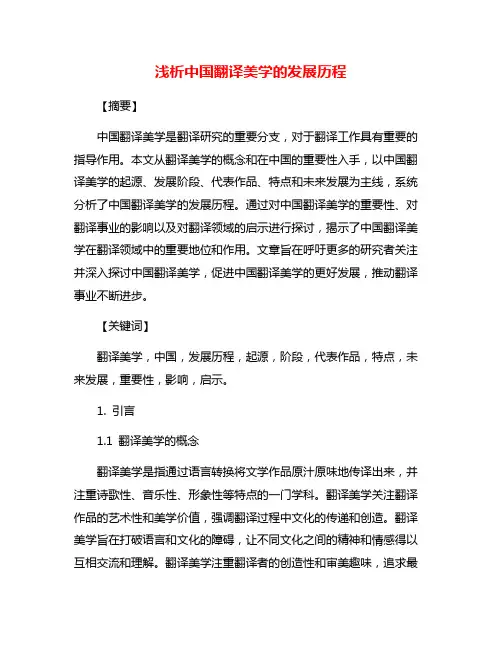
浅析中国翻译美学的发展历程【摘要】中国翻译美学是翻译研究的重要分支,对于翻译工作具有重要的指导作用。
本文从翻译美学的概念和在中国的重要性入手,以中国翻译美学的起源、发展阶段、代表作品、特点和未来发展为主线,系统分析了中国翻译美学的发展历程。
通过对中国翻译美学的重要性、对翻译事业的影响以及对翻译领域的启示进行探讨,揭示了中国翻译美学在翻译领域中的重要地位和作用。
文章旨在呼吁更多的研究者关注并深入探讨中国翻译美学,促进中国翻译美学的更好发展,推动翻译事业不断进步。
【关键词】翻译美学,中国,发展历程,起源,阶段,代表作品,特点,未来发展,重要性,影响,启示。
1. 引言1.1 翻译美学的概念翻译美学是指通过语言转换将文学作品原汁原味地传译出来,并注重诗歌性、音乐性、形象性等特点的一门学科。
翻译美学关注翻译作品的艺术性和美学价值,强调翻译过程中文化的传递和创造。
翻译美学旨在打破语言和文化的障碍,让不同文化之间的精神和情感得以互相交流和理解。
翻译美学注重翻译者的创造性和审美趣味,追求最佳的语言表达和情感传达方式,力求还原原作的精髓和氛围。
翻译美学是翻译学科中的一个重要分支,对于提高翻译质量、加深文化交流具有重要意义。
在当今全球化的背景下,翻译美学更显得尤为重要,它不仅是文学翻译的理论基础,也是文化交流的桥梁和纽带。
通过研究翻译美学,我们可以更好地把握文学翻译的艺术规律和精神内涵,促进不同文化之间的交流与融合。
1.2 翻译美学在中国的重要性翻译美学在中国的重要性可谓至关重要。
翻译作为文化交流的桥梁,在中国具有重要的地位。
通过翻译,中外文化之间得以相互沟通与理解,进而促进不同文化之间的交流与融合。
翻译美学作为翻译活动的一种理论体系,其在中国的发展不仅有利于提高翻译质量,更有助于提升翻译的认知价值和艺术风格。
翻译美学在中国的发展也可以促进翻译研究的深入和规范,引领中国翻译事业迈向更高水平。
翻译美学还可以为中国的翻译人才培养提供理论指导和学术支持,培养更多具备独立思考能力和文化素养的优秀翻译人才。
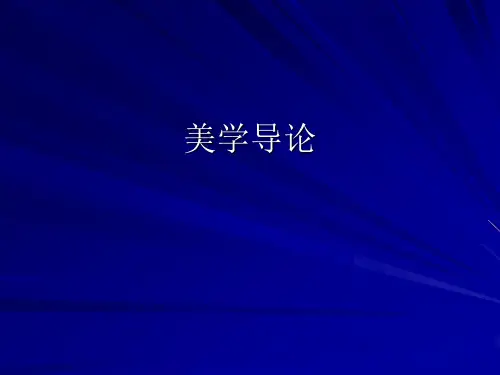
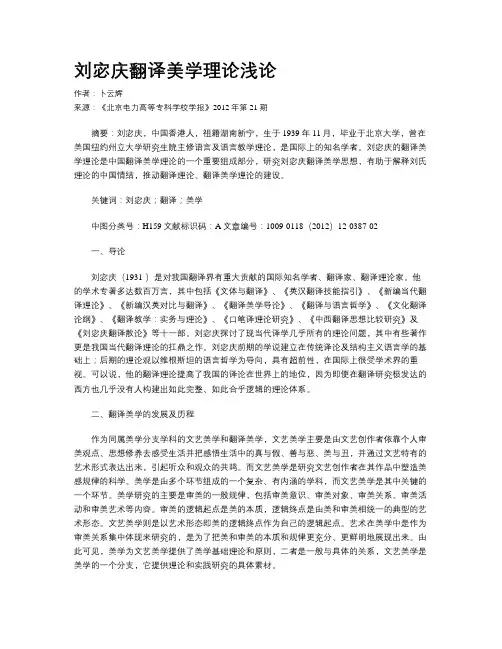
刘宓庆翻译美学理论浅论作者:卜云辉来源:《北京电力高等专科学校学报》2012年第21期摘要:刘宓庆,中国香港人,祖籍湖南新宁,生于1939年11月,毕业于北京大学,曾在美国纽约州立大学研究生院主修语言及语言教学理论,是国际上的知名学者。
刘宓庆的翻译美学理论是中国翻译美学理论的一个重要组成部分,研究刘宓庆翻译美学思想,有助于解释刘氏理论的中国情结,推动翻译理论、翻译美学理论的建设。
关键词:刘宓庆;翻译;美学中图分类号:H159文献标识码:A文章编号:1009-0118(2012)12-0387-02一、导论刘宓庆(1931-)是对我国翻译界有重大贡献的国际知名学者、翻译家、翻译理论家。
他的学术专著多达数百万言,其中包括《文体与翻译》、《英汉翻译技能指引》、《新编当代翻译理论》、《新编汉英对比与翻译》、《翻译美学导论》、《翻译与语言哲学》、《文化翻译论纲》、《翻译教学:实务与理论》、《口笔译理论研究》、《中西翻译思想比较研究》及《刘宓庆翻译散论》等十一部。
刘宓庆探讨了现当代译学几乎所有的理论问题,其中有些著作更是我国当代翻译理论的扛鼎之作。
刘宓庆前期的学说建立在传统译论及结构主义语言学的基础上;后期的理论观以维根斯坦的语言哲学为导向,具有超前性,在国际上很受学术界的重视。
可以说,他的翻译理论提高了我国的译论在世界上的地位,因为即便在翻译研究极发达的西方也几乎没有人构建出如此完整、如此合乎逻辑的理论体系。
二、翻译美学的发展及历程作为同属美学分支学科的文艺美学和翻译美学,文艺美学主要是由文艺创作者依靠个人审美观点、思想修养去感受生活并把感悟生活中的真与假、善与恶、美与丑,并通过文艺特有的艺术形式表达出来,引起听众和观众的共鸣。
而文艺美学是研究文艺创作者在其作品中塑造美感规律的科学。
美学是由多个环节组成的一个复杂、有内涵的学科,而文艺美学是其中关键的一个环节。
美学研究的主要是审美的一般规律,包括审美意识、审美对象、审美关系、审美活动和审美艺术等内容。
翻译美学视角下的审美主体研究——以《生命礼赞》为例摘要:翻译美学研究的是翻译审美主体,审美客体和审美意识活动三者辩证统一的关系。
审美客体即翻译的原语文本和目标语文本,审美主体即译者。
审美主体不仅要进行语言的解码和编码,还要成功地再现美学效果,审美主体在整个美学效果再现中发挥着重要的作用。
因此,审美主体如何发挥其主观能动性对美学视角下的翻译起着至关重要的作用。
关键词:审美主体;审美客体;美学效果;翻译美学美学是研究人对现实的审美关系和审美意识,美的创造、发展及其规律的科学。
根据研究,“美学的诞生可以追溯到18世纪德国的启蒙思想家、哲学家和美学家鲍姆加登,他的《美学》著作的问世标志着一门新的学科“美学”的诞生。
”[1]美学在中国五千年文化中也经历了漫长的时期,像老子,孔子,孟子,庄子等哲学家都对“美”提出过自己的看法。
最初发展起来的美学与人的感性,与艺术有密切的联系。
美学发展到今天,研究范围已经扩大到了生活的各个领域,当代美学家韦尔施评论:“美学必须超越艺术问题,涵盖日常生活、感知态度、传媒文化以及审美和反审美体验的矛盾。
”随着人们对翻译这门学科研究的深入,翻译学科已经和很多领域进行了结合,为翻译实践工作者和理论工作者提供了新的研究视角和成果。
在所有的翻译实践中,文学翻译,尤其是诗学翻译,是最富挑战性,也是最富有争议性、最艰难任务。
“文艺文体不仅‘样式’或‘体裁’很多,言语等级也是最多,文艺作品辞藻婉雅、丰富乃到诡异、驳杂,风格因人而异,莫可穷极。
”[2] 翻译和美学的联姻绝非最近才兴起,早在中国古代佛经翻译中,就已经和美学以及哲学相联系了。
翻译是对原文语言进行解码以及对目标语言进行编码的过程。
我们将翻译和美学相结合,或者用美学理论来研究翻译过程,这就形成了一门新的学科——翻译美学。
所以,翻译美学的研究对象是翻译中的审美客体(原文、译文),翻译中的审美主体,翻译中的审美活动,翻译中的审美判断,审美欣赏,审美标准以及翻译过程中富有创造性的审美再现等等。
毛荣贵-翻译美学毛荣贵,翻译美学,上海交通大学出版社,2005年11月●翻译美学的研究对象是翻译中的审美客体(原文、译文),翻译中的审美主体(译者、读者),翻译中的审美活动,翻译中的审美判断,审美欣赏,审美标准以及翻译过程中富于创造性的审美再现等等。
●生在杭州,吃在广州,死在柳州。
It is good to live in Hangzhou, to eat in Guangzhou, and to die in Liuzhou.(意合美,译文无审美价值,无基本的“有效性”及“合适性”)语感中包含了美感的译者,其译文将是:There are three best choices in China-living in Hangzhou, eating in Guangzhou and buying a wooden coffin in Liuzhou.(p. 23)●As a youngster I was effervescent, outgoing, a nd I talked too much. I had a talent for sayingthe wrong things at the wrong time. I tortured myself because of the foolish things I had said.有基本语感的译者会译成:我年轻的时候,活力四射,乐于助人,非常健谈,却不知道在什么场合说什么话。
言既出口,内心又懊恼不已。
试译:我年轻的时候,活力四射,乐于助人,非常健谈,而且还有在错误的场合发表错误言论的才能。
言既出口,内心又懊恼不已。
(23-24)●The dress set off to perfection the seventeen-inch waist, the smallest in three counties, andtightly fitting basque showed breasts well matured for her sixteen years.(Gone with the Wind) 傅东华:她的腰围不过十七英寸,穿着那窄窄的春衫,显得十分合身。
从翻译美学看文学翻译审美再现的三个原则一、本文概述翻译作为一种跨语言、跨文化的交流活动,在文学领域扮演着至关重要的角色。
它不仅涉及到语言层面的转换,更需要在审美层面上实现原文的艺术再现。
翻译美学,作为研究翻译审美问题的新兴学科,为文学翻译提供了全新的视角和理论支撑。
本文旨在从翻译美学的视角出发,探讨文学翻译审美再现的三个原则,以期深化对文学翻译本质和规律的认识,提高翻译质量,促进不同文化之间的交流与理解。
具体而言,本文首先将对翻译美学的基本概念和理论框架进行阐述,明确其在文学翻译中的指导意义。
随后,结合具体的文学翻译实践案例,详细分析审美再现的三个原则:忠实性原则、创造性原则和可接受性原则。
忠实性原则要求翻译在传递原文意义的保持原文的美学特质和风格;创造性原则强调翻译在尊重原文的基础上,发挥译者的主观能动性,进行艺术再创造;可接受性原则则关注译文读者的审美需求和文化背景,力求使译文易于理解和接受。
通过对这三个原则的深入探讨,本文旨在揭示文学翻译审美再现的内在规律和机制,为翻译实践提供有益的指导和借鉴。
本文也期望能够引起更多学者和翻译工作者对翻译美学问题的关注和研究,共同推动文学翻译事业的发展和进步。
二、翻译美学的理论基础翻译美学,作为一种跨学科的研究领域,其理论基础主要源自语言学、美学、文艺学等多个学科。
在语言学方面,翻译美学强调语言的美感和表达力,关注源语言和目标语言之间的转换过程中美的传递和再现。
美学和文艺学则为翻译美学提供了审美判断和评价的标准,帮助我们理解文学翻译中如何保持原作的美学特征和审美价值。
翻译美学的理论基础还包括了翻译理论和翻译实践的结合。
翻译理论为翻译美学提供了指导和支持,帮助我们理解翻译的本质和规律。
而翻译实践则是翻译美学的实证基础,通过具体的翻译案例,我们可以分析和总结出翻译美学在文学翻译中的应用和效果。
在翻译美学的理论框架中,审美再现是核心问题之一。
审美再现指的是在翻译过程中,如何尽可能地保持原作的美学特征和审美价值,使读者在阅读译文时能够获得与阅读原作相似的审美体验。
从诗歌翻译浅谈翻译美学一、引言美学历史源远流长,其诞生要追溯到18世纪德国启蒙思想家,哲学家和美学家鲍姆加登于1750年首次明确提出创立一门新学科Aesthetica,即美学。
美学在20世纪进入中国,就立刻在中国学术界扮演了活跃的角色,从不同立足点出发的美学体系不断涌现,“翻译美学”就是其中之一。
何谓“翻译美学”?翻译美学的研究对象是翻译中的审美客体(原文、译文),翻译中的审美主体(译者、读者),翻译中的审美活动,翻译中的审美判断、审美欣赏、审美标准以及翻译过程中富有创造性的审美再现等。
二、从诗歌翻译揭示翻译的美学内涵诗歌翻译是文学翻译的极高境界。
诗歌丰富的语言内涵,优美的语言形式在语际转换中使诗歌语言形式与内容间的冲突尤为突出,甚至到了无法兼顾的程度。
有人认为诗歌翻译是不可能的。
然而,许渊冲先生认为译诗不但可能,而且译出的诗甚至可能超越原诗。
他在清楚意识到诗歌的审美特质后,提出了著名的“三美论”。
本文认为,这三美首先要以翻译的准确性为基础,尤其在汉诗英译的过程中,更要了解诗歌背后的历史背景和文学内涵,再以三美为目标,译出令人满意的作品。
1.准确性19世纪末,英国剑桥大学Herbert A. Giles教授所译的唐诗集在世界文学史上占有独特的地位,但其中一些诗,未能真正理解中国深厚的文化底蕴,脱离了原意,形式意境虽美,又怎能让人领略原诗真正的美呢?月夜亿舍弟戌鼓断人行,边秋一雁声。
露从今夜白,月是故乡明。
有弟皆分散,无家问死生。
寄书长不达,况乃未休兵。
――杜甫To His BrotherThe evening drum has emptied every street,One autumn goose screams on its frontier flight,The crystal dew is glittering at my feet,The moon sheds,as of old,her silvery light.The brothers,―ah,where are they?Scattered each;No home whence one might learn the others’harms.Letters have oft miscarried:shall they reachNow when the land rings with the clash of arms?――Giles诗人夜闻戌楼更鼓,街上已无行人。
从翻译美学角度看英文化妆品广告翻译一、引言随着全球化的发展,英文广告在中国市场越来越普遍。
其中,化妆品广告是一种常见的英文广告类型。
化妆品广告的翻译不仅需要准确传达产品信息,还需要传达广告的情感和美学效果。
因此,本文旨在从翻译美学角度探讨英文化妆品广告翻译,以期为翻译实践提供一定的参考。
二、翻译美学的基本概念和研究方法翻译美学是翻译学的一个分支,主要研究翻译作品的美学特征和美学效果。
翻译美学的基本概念包括翻译美学原则、翻译美学效果和翻译美学评价等。
其中,翻译美学原则是指在翻译过程中应遵循的美学原则,如忠实原则、美感原则、可读性原则等。
翻译美学效果是指翻译作品所产生的美学效果,如情感效果、审美效果、文化效果等。
翻译美学评价是指对翻译作品进行美学评价的过程,如评价翻译作品的美学价值、美学质量等。
翻译美学的研究方法包括文献研究法、实证研究法和比较研究法等。
其中,文献研究法主要是通过查阅相关文献,了解翻译美学的基本概念和理论框架。
实证研究法主要是通过实际翻译实践,探讨翻译美学原则的实际应用效果。
比较研究法主要是通过比较不同语种的翻译作品,分析翻译美学效果的差异和原因。
三、英文化妆品广告的特点和翻译难点英文化妆品广告具有以下特点:1. 语言简洁明了。
英文化妆品广告通常采用简洁明了的语言,以便于消费者快速理解产品信息。
2. 情感色彩浓厚。
英文化妆品广告通常注重情感营销,通过情感化的语言和形象,吸引消费者的注意力。
3. 美学效果突出。
英文化妆品广告通常注重美学效果,通过精美的图片和文字,营造出高贵、优雅的形象。
英文化妆品广告的翻译难点主要包括以下几个方面:1. 语言差异。
英文和中文的语言结构和表达方式存在较大差异,翻译时需要注意语言的转换和调整。
2. 文化差异。
英美文化和中国文化存在较大差异,翻译时需要注意文化的转换和调整。
3. 美学效果的传达。
英文化妆品广告注重美学效果的营造,翻译时需要注意如何传达美学效果,使翻译作品具有相同的美学效果。
美学专业参考书目美学是哲学的一个分支,研究艺术、审美、美的本质等问题。
以下是一些美学专业的参考书目,这些书籍涵盖了美学的基本理论、历史发展以及相关的艺术理论等方面:1.《美学导论》(Introduction to Aesthetics)- Roger Scruton:•作者Roger Scruton是一位著名的英国哲学家,该书对美学的基本问题进行了全面而深入的介绍。
2.《美的批判》(Critique of the Aesthetic Judgment)-Immanuel Kant:•康德是美学领域的重要思想家,这本书是他对美学的经典著作,探讨了审美判断的原则。
3.《漫谈艺术》(Art as Experience)- John Dewey:•约翰·杜威是一位美国哲学家和教育家,他在这本书中探讨了艺术体验的哲学意义,强调艺术与生活的密切关系。
4.《艺术的领域》(The Field of Cultural Production)- PierreBourdieu:•皮埃尔·布迪厄是一位社会学家,他的这本书从社会学的角度分析了艺术领域的结构和运作机制。
5.《艺术的起源》(The Origin of the Work of Art)- MartinHeidegger:•马丁·海德格是德国哲学家,该书探讨了艺术作为存在的一种方式,对美学有深刻的影响。
6.《反对解释》(Against Interpretation)- Susan Sontag:•苏珊·桑塔格是一位美国文学评论家,她在这本书中提出了对解释艺术的批判性见解,主张直接体验艺术。
7.《美学的焦虑》(The Anxiety of Influence)- Harold Bloom:•哈罗德·布鲁姆是文学评论家,该书探讨了文学创作中的影响力和创新问题,对美学领域有启发性的见解。
这些书籍代表了美学领域的一些重要思想和理论,你可以根据自己的兴趣和学术需求选择阅读。